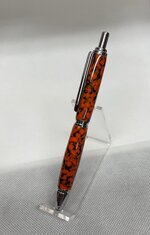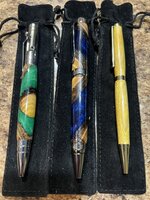RGVPens
Member
I've got a rookie question about blanks. I've looked and don't see exactly what I'm looking for.
I see a BUNCH of different resin blanks, and have turned some, but I'm looking for a list/ranking of ones easiest to hardest to work with from a beginner's point of view.
I would like to "work my way through" the plastics and think Alumilite might be the first step. It seems to be very easy to turn smoothly. This might be a good list to make and put in the library...unless it's there and I didn't find it. I'm talking about all the standard types and names that you can find on most supplier's websites Acrylic, Rhino, Kirinite, Aquapearl, Pen-Stone, Acrylester, Mica Pearl, Tru-Stone, and the list goes on and on. NOT all the different types of home brew, that would be too crazy.
That way all of us newbies, and maybe some not so new, could start at the beginning and add the next new type as we learn and progress without jumping too far ahead of our developing skills.
Am I crazy...wait, don't answer that  Does that seem like a reasonable idea? Again, it may already be out there, if so please tell me where to find it.
 Does that seem like a reasonable idea? Again, it may already be out there, if so please tell me where to find it.
I see a BUNCH of different resin blanks, and have turned some, but I'm looking for a list/ranking of ones easiest to hardest to work with from a beginner's point of view.
I would like to "work my way through" the plastics and think Alumilite might be the first step. It seems to be very easy to turn smoothly. This might be a good list to make and put in the library...unless it's there and I didn't find it. I'm talking about all the standard types and names that you can find on most supplier's websites Acrylic, Rhino, Kirinite, Aquapearl, Pen-Stone, Acrylester, Mica Pearl, Tru-Stone, and the list goes on and on. NOT all the different types of home brew, that would be too crazy.
That way all of us newbies, and maybe some not so new, could start at the beginning and add the next new type as we learn and progress without jumping too far ahead of our developing skills.
Am I crazy...wait, don't answer that





